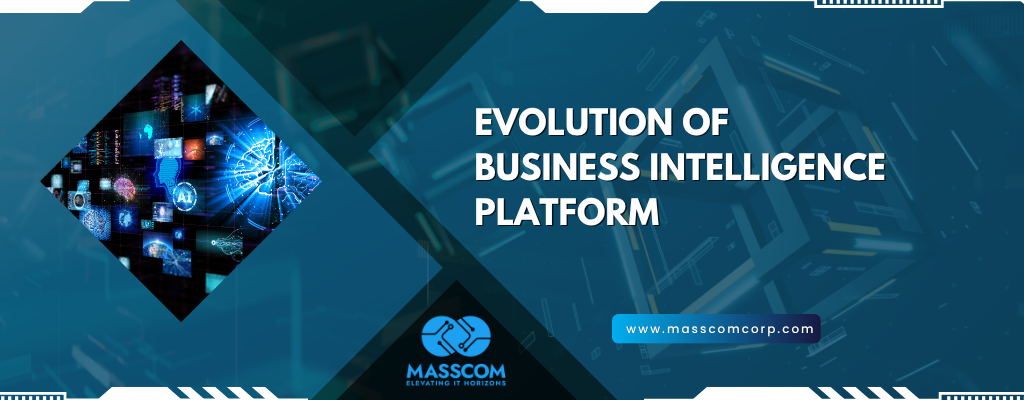In the digital economy, data is more than just numbers—it’s a powerful asset. For decades, businesses have relied on dashboards to gain insights from their data, but today’s competitive landscape demands more than static reports. We are witnessing a transformative shift in Business Intelligence (BI), moving from simple dashboards to dynamic, decision-centric platforms that empower real-time, AI-driven actions.
This evolution in BI is not just technological; it’s strategic. Businesses no longer just want to visualize data; they want to understand, predict, and act on it. Let’s explore the journey of BI platforms, and how they are revolutionizing decision-making across industries.
The Traditional BI Era: Dashboards and Descriptive Analytics
Historically, BI tools were designed to compile, process, and display data in the form of charts, graphs, and dashboards. They answered the “what happened?” and occasionally “why did it happen?”
- Data Sources: Structured databases, spreadsheets, and CRM/ERP systems.
- User Base: Primarily analysts and business intelligence professionals.
- Limitations: Static reports, lag in data refresh, limited predictive capability, and a reliance on human interpretation.
While dashboards were revolutionary at the time, enabling clearer insights and improved transparency, they were retrospective by nature. The evolution began when businesses started asking, “What’s going to happen next? And what should we do about it?”
What’s New in BI: Trends & Key Features
Generative & Natural Language Analytics
Tools like Google Looker and Microsoft Power BI are pushing toward BI that responds to plain-English queries and even auto-generate reports and visualizations from prompts. Users can ask “What will sales look like next quarter?” or “Why did our customer churn spike last week?” and get actionable narratives without manual data wrangling.Embedded AI & Agentic Capabilities
Companies are embedding “agentic AI” (autonomous AI agents) into BI to perform tasks like anomaly detection, root cause analysis, and alerting without requiring human initiation. Cisco’s new Data Fabric platform, for example, improves how organizations handle massive machine-data flows so that AI tools can act faster. The Times of IndiaPredictive & Real-Time Forecasting
Real-time data streams combined with ML allow BI systems to forecast trends and detect anomalies as soon as they appear. Databricks’ recent AI/BI enhancements let users add “AI forecast” overlays to dashboards directly, turning historical data into future-focused insights. DatabricksUnified Platforms & Governance
Enterprises are preferring BI suites that bring everything together — data integration, AI, visualization, collaboration — while preserving strong governance and data quality. For instance, Power BI was named a leader in Forrester’s Q2 2025 BI platforms evaluation, especially for its generative AI features and broad capabilities.AI-Powered Anomaly Detection & Root Cause Analysis
Modern systems are getting better at flagging unexpected behavior (sales drop, ops issue, fraud risk) automatically. Beyond flagging anomalies, AI models are being used to dig into why something happened, suggesting potential root causes and even potential responses.More Accessible Self-Service & Embedded Analytics
Non-technical and business users are benefiting from NLP (natural language processing), drag-and-drop dashboards, and BI embedded directly in business apps. These reduce bottlenecks and let insights reach decision-makers faster. Platforms like Qlik Sense, Tableau, and Looker are enhancing these features. Best Ai ToolsCollaboration & Action triggering
BI tools are now designed not just for viewing data, but for acting on it: alerting, automatic workflows, embedded actions (like adjusting campaign spend, triggering inventory restock). This tight coupling between insight and action is what separates modern, “actionable” BI from older, observation-focused BI.
Impact Across Industries
Let’s examine how the evolution of BI platforms is impacting three different industries: Healthcare, Retail, and Manufacturing.
1. Healthcare: From Patient Records to Predictive Care
Traditional Challenges:
Healthcare providers often struggled with siloed patient data, outdated record systems, and reactive care approaches. Insights were largely retrospective, focusing on treatment outcomes rather than prevention.
BI Transformation:
Modern BI platforms now aggregate data from EHRs (Electronic Health Records), wearables, lab systems, and claims data into centralized, secure environments. These systems use predictive analytics to:
- Forecast patient deterioration and enable early interventions.
- Optimize hospital resource allocation like beds, staff, and equipment.
- Personalize treatment plans based on historical and genetic data.
Outcome:
Hospitals using modern BI systems report improved patient outcomes, reduced readmission rates, and better operational efficiency.
Lets discuss your next project
2. Retail: From Sales Reports to Customer-Centric Experiences
Traditional Challenges:
Retailers relied on sales reports, inventory logs, and customer feedback forms. Decision-making was slow, and personalization was limited.
BI Transformation:
Retail BI platforms now unify POS data, website/app analytics, customer reviews, loyalty programs, and supply chain systems to provide:
- Real-time inventory insights and demand forecasting.
- Hyper-personalized marketing based on customer behaviour and preferences.
- Dynamic pricing models powered by competitive analysis and seasonality.
Outcome:
Retailers using modern BI experience increased sales conversions, better customer retention, and reduced overstock or stockouts.
3. Manufacturing: From Production Metrics to Predictive Maintenance
Traditional Challenges:
Manufacturers used BI primarily for monitoring production KPIs, defect rates, and supply chain performance. Data was often delayed, and machine failures resulted in costly downtimes.
BI Transformation:
With IoT and smart factory technologies, BI platforms now offer:
- Predictive maintenance alerts using sensor data from equipment.
- Supply chain optimization with real-time logistics tracking.
- Quality control insights powered by anomaly detection in production lines.
Outcome:
Companies are reducing equipment failures, improving yield, and enhancing operational agility.
What’s Driving This Evolution?
Several trends are accelerating the shift from dashboards to decision-centric BI platforms:
- Cloud Adoption: Scalable, cost-effective access to big data.
- Data Democratization: Tools are now accessible to all business units.
- AI/ML Maturity: Increased trust and accuracy in predictive models.
- Business Agility Needs: Faster decision cycles in competitive markets.
These trends reflect a growing need for platforms that don’t just report on the past but shape the future.
The Road Ahead: Decision Intelligence
The next evolution of BI lies in Decision Intelligence — the integration of data science, decision modeling, and automation. This enables organizations to:
- Model complex decision-making scenarios.
- Simulate outcomes based on different inputs.
- Automate routine decisions through AI agents.
In essence, Decision Intelligence turns BI into an operational function, not just an analytical one.
The journey from dashboards to decisions marks a new era in how organizations harness the power of data. Business Intelligence is no longer a static reporting function—it is becoming the central nervous system of enterprise strategy.
As industries continue to digitize, the companies that will lead are those who can transform raw data into real-time action. Investing in modern BI platforms isn’t just about technology—it’s about future-proofing decision-making.
For IT leaders, developers, and business strategists, understanding this evolution is essential. Because the future isn’t just about visualizing data; it’s about acting on it, intelligently and instantly.


